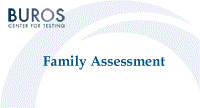Buros-Nebraska Series on Measurement and Testing

Family Assessment
Date of this Version
1995
Document Type
Article
Citation
Family Assessment, ed. Jane Close Conoley & Elaine Buterick Werth (Lincoln, NE: Buros Institute of Mental Measurements, University of Nebraska-Lincoln, 1995).
Abstract
This chapter has several goals. First, I will briefly review the history of measurement as it applies to family assessment. This history has been recounted by many and is available in many recent publications, so I shall be fairly brief. Second, I will discuss family measurement in terms of important issues still facing the family measurement field-issues that are not, in my opinion, being well addressed at this time. And finally, I will attempt to weave these various threads into some speculations about the future directions that family measurement might (or maybe needs) to take.
I will confine this discussion to quantitative measurement because the available space does not permit any extensive discussion of the growing area of qualitative research. I will confess that although my biases permit qualitative research to be complementary to quantitative research, I believe we will always find it necessary to use quantitative measures when we entertain questions involving comparisons across families or when we desire generalizations to populations with certain defined characteristics.
Let me be clear about what is meant by quantitative research methods. Quantitative measurement is simply the assigning of numerical values to abstract, theoretical constructs that constitute the core of family theory. Further, my emphasis is not on measures pertaining to individuals but rather on family measures-when a family relationship is measured or a set of relationships in the family are measured (See Draper & Marcos, 1990; Huston & Robins, 1982; and Thompson & Walker, 1982, among others for discussions on individual- vs. family-level measurement). Note that the distinctions made about family versus individual measurement are independent from types of measurement (e.g., observations, self-report, diaries) as well as data analytic techniques (e.g., combining scores from different family members, using dyadic codes, etc.).
When discussing the measurement of relationships we can for our purposes summarize a definition of relationship as clearly involving more than one individual over time (Wampler & Halverson, 1993). When considering the conceptualization of family relationships, we must also take into account the idea that families have a specifiable past and an expected future-that is, the relationships are intimate and extended as opposed to casual and brief.
Before I discuss history and issues, I will mention just one brief aside about family theory and its relation to measurement of family constructs. For most family researchers in the past, there has been a conscious attempt to link broad, theoretical positions to certain types of measurement. For example, symbolic interactionists have demonstrated a strong commitment to qualitative, grounded methods, whereas behaviorists have verified their commitment to observational data by focusing on behaviors, right down to microcoding small behavioral sequences in family interactions.
My position is that measurement cannot be formulated without theory-such a theory is not a global theory, however, but rather a set of theories about constructs that will dictate what measures we should collect to identify each abstract construct. This theory about measurement stems from a "multiplist position" (Houts, Cook, & Shadish, 1986) that advances a measurement pluralism where every abstract social science construct is best measured from multiple perspectives-no one measurement system (self-report, observational, short-term, long-term, etc.) is adequate to measure any complex construct. Every construct's meaning is more than that indicated by anyone measure, source, setting, etc. I will return to this notion of "construct building" when we discuss some of the shortcomings of current-day family assessment. (See also Bank, Dishion, Skinner, & Patterson, 1990; Patterson & Bank, 1989.)
HISTORY
In our recent chapter on quantitative measurement we proposed that the history of family measurement coincides with the history of the scientific study of the family (Wampler & Halverson, 1993). It has culminated with the multiagent and multimethod strategies that are increasingly being used today.
MEASUREMENT OF MARRIAGE VARIABLES
The earliest attempts at measurement of marriage were almost entirely based on self-reports and focused on indicators of either satisfaction or marital adjustment (Burgess & Cottrell, 1939; Locke, 1951; Locke & Williamson, 1958). Revisions of early measures by Spanier (1976), along with Gottman's (1979) research indicating the centrality of marital adjustment and satisfaction for marital functioning have led to many measures of the core evaluative constructs of marriage. For the most part, they are self-report and individually based measures that are widely used today in nearly every study of marriage.
In the area of marriage assessment, there has been what could be termed a growing methodological dualism with the rise of observational studies of marital interaction in the late 60s and 70s, continuing to the present. Beginning in the 60s at the Old Child Research Branch (where I had a new post-doctoral assignment), Harold Rausch and his colleagues began the study of filmed marital improvisations (Rausch, Barry, Hertel, & Swain, 1974). Later, his colleagues Bob Ryder and Dave Olson began to use adaptations of the old Revealed Difference technique along with such innovative assessments of interaction as the color-matching test (e.g., Olson & Ryder, 1970).
Included in
Educational Assessment, Evaluation, and Research Commons, Family, Life Course, and Society Commons, Quantitative, Qualitative, Comparative, and Historical Methodologies Commons


Comments
Copyright © 1995 by Buros Institute of Mental Measurements. Digital Edition copyright © 2012 Buros Center for Testing.